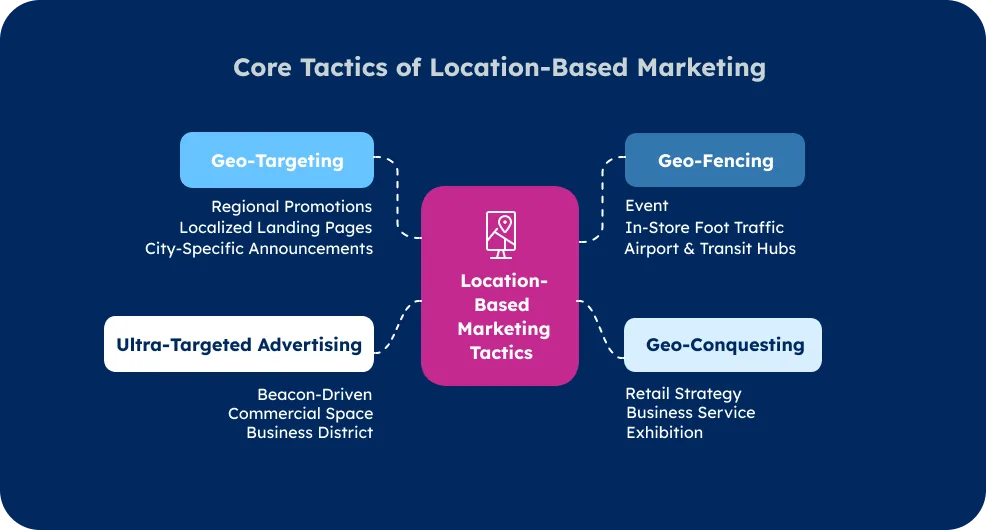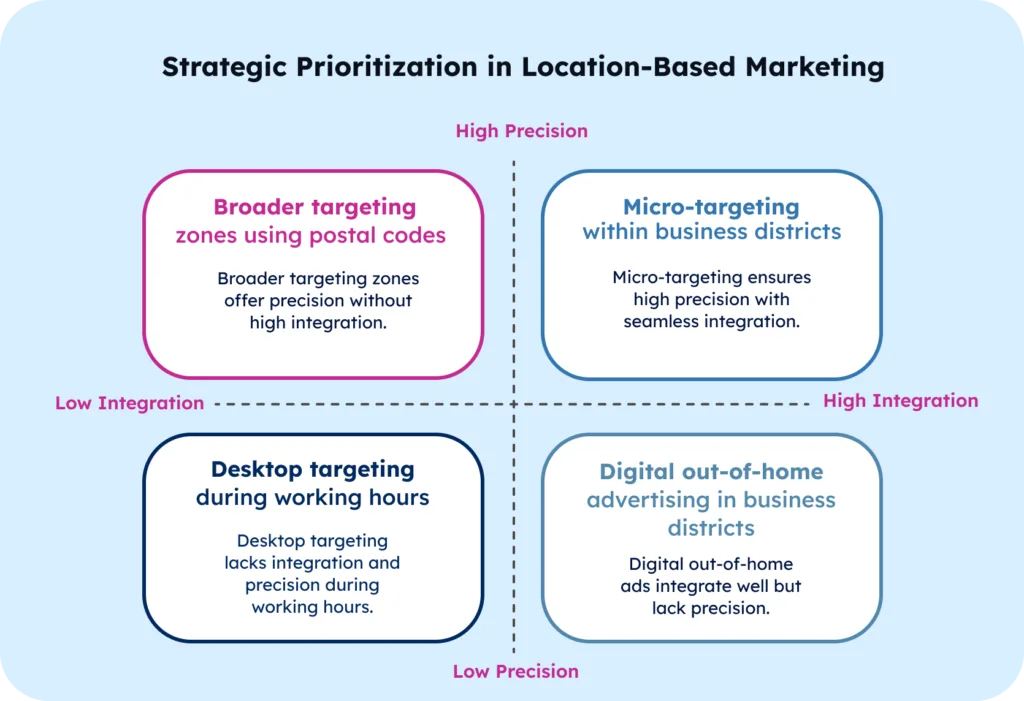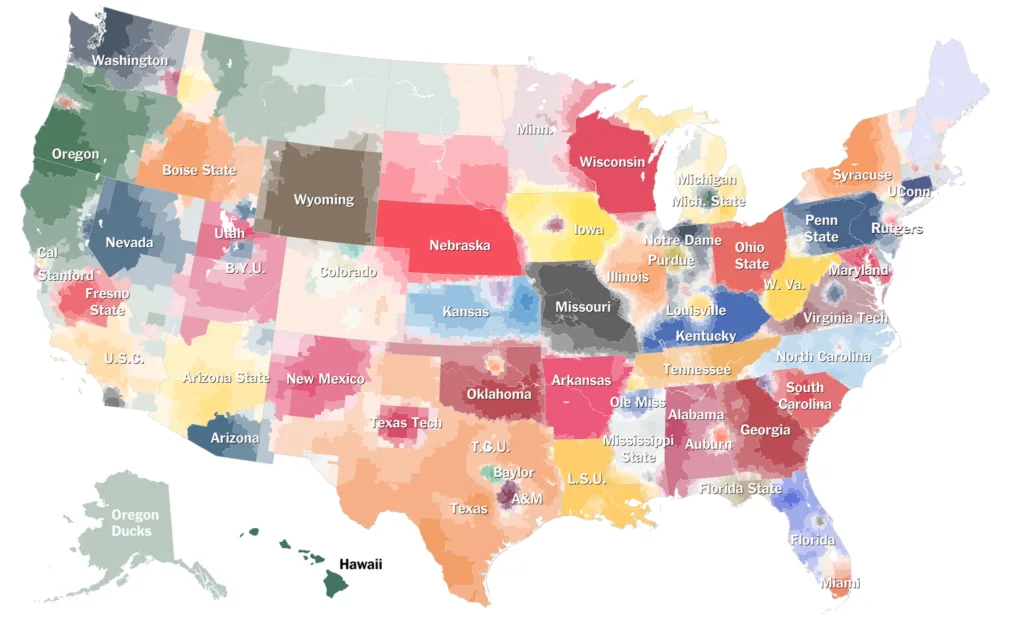Introduction
In marketing, you may want to connect with potential clients precisely where they make business decisions or complete transactions. High-quality zip code and address data let you focus your marketing efforts on commercial districts and physical spaces where your target audience is most engaged.
This guide will walk you through the fundamentals of geolocation advertising, examine the four essential tactics, and provide actionable strategies for maximizing your campaign’s business impact and return on investment.
💡 Use the most comprehensive worldwide ZIP code and population data from GeoPostcodes to send geo-marketing messages to your target customers. Our data is updated weekly, relying on more than 1,500 sources. Browse GeoPostcodes datasets and download a free sample here.
What is Geolocation Advertising?
Geolocation advertising delivers marketing messages to potential customers based on their real-world location. Rather than broadly targeting entire regions, you can precisely direct ads to specific zip codes, business districts, or even store aisles that matter most to your brand. Combining accurate address data with contextual information—such as competitor proximity or past customer behavior—creates more relevant ads and optimizes your marketing budget for maximum efficiency.
The Four Core Tactics of Location-Based Marketing
Geolocation advertising typically relies on one (or a strategic combination) of these four fundamental tactics:

Geo-Targeting
Definition
Geo-targeting uses IP addresses, ZIP codes, and sometimes GPS data to direct advertisements exclusively to users in specific regions. The regions include a metropolitan area, selected business districts, or particular zip codes.
Applications & Examples
Geo-targeting offers versatile applications across various business scenarios:
- Regional promotions: financial services firms seeking technical clients can tailor campaigns to Silicon Valley ZIP codes, ensuring their messaging reaches only prospects in that innovation hub.
- Localized landing pages: businesses serving multiple states can automatically display local phone numbers and region-specific offers when visitors from those areas access their website.
- City-specific announcements: a coworking space network might promote an exclusive networking event to Chicago users while offering a different membership to prospects in Boston.
Why It Works
This approach strikes an optimal balance between budget efficiency and market coverage. Focusing exclusively on relevant geographic areas eliminates spending on impressions outside your target market. This approach helps you create more appealing ads that speak directly to local business needs and interests.
Geo-Fencing
Definition
Geo-fencing establishes virtual perimeters around specific geographic locations, including convention centers, commercial districts, or transportation hubs. It triggers targeted messages whenever a user’s mobile device crosses those predetermined boundaries.
Applications & Examples
The precision of geo-fencing enables highly contextual marketing opportunities.
- Event targeting: creates a virtual fence around conference venues hosting major industry trade shows and delivering timely invitations to booth presentations or networking sessions when attendees enter the zone.
- In-store foot traffic strategies: allow retailers to set fences around branch locations, automatically sending welcome coupons or navigation assistance when shoppers approach within 200 meters.
- Airport and transit hub applications: enable business service providers or transportation apps to send targeted offers to professionals arriving at major international airports or central business district transit stations.
Why It Works
By identifying precisely when someone physically enters a zone relevant to your business, geo-fencing concentrates your marketing investment on immediately accessible people, creating the perfect alignment of the right place and the right time.
Geo-Conquesting
Definition
Geo-conquesting strategically targets users located near or inside competitor locations, presenting compelling incentives to consider your brand as an alternative.
Applications & Examples
This competitive approach creates immediate differentiation opportunities.
- Retail competitive strategy enables premium retailers to deliver exclusive discount offers to customers actively browsing in competitor stores.
- Business service differentiation allows professional service firms to target users attending competitor seminars by inviting them to download comparison guides or schedule consultations.
- Exhibition engagement empowers conference exhibitors to fence rival booths and deliver targeted communications highlighting their unique value propositions to attendees actively exploring competitor offerings.
Why It Works
By presenting a direct alternative when someone engages with a competing solution, you create a powerful opportunity to highlight your differentiation and potentially redirect their business interest.
Ultra-Targeted Advertising
Definition
Ultra-targeted advertising transcends building-level accuracy by utilizing real-time location signals—such as Bluetooth beacons or commercial Wi-Fi networks—to detect a user’s exact position within indoor environments. This precision allows for hyper-relevant offers based on their specific location context, purchase history, or digital behavior patterns.
Applications & Examples
This advanced approach enables remarkably personalized marketing moments.
- Beacon-driven engagement: allows premium retail apps to detect when users enter specific departments, remind them of previously viewed products, and deliver timely incentives to complete their purchase journey.
- Commercial space optimization: empowers office building managers to leverage indoor positioning to understand professional traffic patterns and deliver targeted service promotions at optimal decision points.
- Business district targeting: utilizes marketing technology to track engagement duration in specific commercial zones. When professional density indicates high potential, relevant business service offers are triggered.
Why It Works
Relevance reaches its maximum potential. When advertisements arrive when a decision-maker evaluates solutions, they function more as valuable assistance than interruption—driving higher conversion rates and meaningful engagement.
Benefits of Geolocation Marketing
Focusing your advertising efforts on the precise locations where business decision-makers work or conduct activities yields significant advantages:
Higher Precision, Stronger ROI
Wasting impressions will be reduced by narrowing your advertising focus to specific zip codes, commercial districts, or even competitor locations. Also, you can concentrate your budget where it generates measurable results.
Immediate Context
Advertisements are delivered when someone is physically present in a relevant business context, including a commercial district, industry event, or competitor location. These advertisements are more valuable and timely than generic campaigns lacking location intelligence.
Actionable Data
Each geolocation campaign generates valuable insights into business customer behavior patterns. For example, you can analyze the number of professionals from certain geofenced zones who visit your location, whether geo-conquesting effectively redirects competitor traffic, or which business districts yield your highest-value engagements.
Example: A professional services firm specializing in regulatory compliance can develop distinct geo-targeting campaigns for financial district zip codes versus areas known for technology startups. Both zones receive highly relevant messaging, generating more qualified leads and higher conversion rates.
Three Strategies to Support Your Geolocation Campaigns
While each core tactic forms the foundation of location-based marketing, these complementary strategies significantly enhance campaign performance:
Time-Based Targeting
Combine precise location data with optimal timing patterns. If foot traffic near a business hub peaks during morning and evening commute hours, concentrate message delivery during those windows. Similarly, if corporate decision-makers typically browse professional content during lunch breaks, align your B2B messaging with those specific timeframes.
Digital Out-of-Home (DOOH) Integration
Coordinate mobile campaigns with strategically placed digital displays in business environments, executive elevators, or transit hubs. Consistent messaging across personal devices and environmental media creates powerful recall and drives higher response rates for professional events, service offerings, or executive briefings.
Cross-Device Retargeting
After a professional engages with your mobile advertisement in a geofenced business zone, retarget them across desktop and tablet. This reinforces your value proposition and encourages high-value actions like downloading research, registering for events, or scheduling consultations.

Leveraging Population Data to Supercharge Your Geolocation Campaigns
Population data adds another powerful dimension to your geolocation advertising strategy. Understanding who lives and works in specific areas helps you create more targeted campaigns with higher conversion rates. Knowing the demographic makeup of different zip codes allows you to customize your messaging to match the audience’s needs and preferences.
For campaign planning, population data reveals where your ideal customers are concentrated. You’ll discover which neighborhoods have the right mix of age groups, income levels, and household sizes for your products. This knowledge lets you allocate your marketing budget more efficiently by focusing on the highest potential return zip codes.
Population density information also guides channel selection. Dense urban areas might respond better to mobile ads, while suburban regions might engage more with direct mail campaigns. Knowing which zip codes have growing populations for retail businesses helps identify promising locations for expansion.
When analyzing campaign performance, population data provides crucial context. If an ad performs exceptionally well in an area with specific demographics, you can remake that success by targeting similar populations elsewhere. On the contrary, underperforming areas with your target demographics might signal issues with your messaging or offer.
Harnessing Football Data to Enhance Geolocation Campaigns
Football (soccer) data offers unexpected advantages for location-based marketing strategies. Fan concentration data by zip code reveals valuable audience segments with shared interests and spending patterns. This information helps you create campaigns that resonate with local fan cultures.

For campaign planning, football stadium proximity often indicates commercial hotspots with high foot traffic before and after matches. Mapping team popularity across regions lets you align promotions with local team colors or reference recent victories in areas with strong fan bases.
Football event calendars provide context for engagement spikes or dips when analyzing campaign performance. Ads might perform exceptionally well before home games in specific neighborhoods or show decreased engagement during away matches when fans travel.
Ticketing service providers tend to need such data. As the number one provider in Europe and number two worldwide, Eventim significantly improved audience targeting precision by implementing comprehensive postal data and geocoordinates for zip code matching and distance calculation. This led to measurable improvements in their marketing campaign effectiveness.
Measuring Success and Overcoming Challenges
Key Performance Indicators
Successful geolocation advertising requires monitoring specific metrics that reveal true business impact.
First, location engagement involves analyzing interaction rates within each targeted business zone or zip code.
Second, conversion patterns measure the percentage of professionals exposed to your location-based messages who subsequently visit your business locations or complete desired actions.
Third, cross-location analysis identifies which business districts, competitor proximities, or commercial zones consistently generate your highest-value conversions.
Overcoming Privacy Hurdles
Since geolocation leverages sensitive location data, maintaining rigorous compliance standards is essential. Implement transparent opt-in mechanisms and strictly adhere to regional regulations like GDPR or CCPA. A comprehensive privacy framework builds professional trust and encourages meaningful engagement with your location-based initiatives.
Data Accuracy
Even minor errors in geofence parameters or misclassified zip codes can significantly impact campaign performance. Imprecise radius settings may also create negative impressions if professionals receive promotions for locations impractically distant from their actual business environments.
Best Practices for Geolocation Advertising
Success in geolocation advertising depends on precision in your database and strategic approach. Let’s examine the critical practices that distinguish high-performing campaigns.
Data Quality and Management
Location data quality is the foundation of effective geolocation advertising. Working with verified zip code data ensures your targeting reaches the correct business districts and commercial zones. This becomes particularly crucial when targeting areas with complex postal structures, such as the UK or Japan, where zip codes can define particular commercial locations.
When implementing your targeting strategy, remember to consider these essential elements:
Location Data Accuracy
Your campaign’s success depends on precise geographic coordinates and postal boundaries. High-quality location data helps you target specific business districts with confidence, define accurate radius parameters around key commercial locations, and ensure your messages reach intended decision-makers in relevant zones.
Example of data quality impact: A growing professional services firm might rely on outdated commercial zone boundaries and miss newly developed business parks. Potential clients in those areas would never receive relevant service offers, causing the company to miss valuable opportunities and waste its advertising budget on areas outside its accurate target market.
Privacy-First Approach
Modern geolocation advertising requires a sophisticated balance between targeting capabilities and privacy compliance. To achieve this balance, transparent opt-in processes and clear data usage policies should be implemented. This will build professional trust while maintaining targeting effectiveness.
Message Relevance
Location alone isn’t sufficient because your messaging must align with the business context of each targeted area. For instance, when targeting a financial district, your advertisements should address the unique challenges and opportunities facing banking and investment professionals.
Conclusion
As shown in this article, geolocation advertising varies significantly across implementation methods, highlighting the complexity involved. These approaches are helpful, whether using zip codes for targeting, creating virtual boundaries around commercial areas, focusing on competitor locations, or using beacon technology for indoor precision. They deliver unmatched accuracy in reaching your audience at optimal moments.
Managing these variations in location data demands considerable resources that most companies don’t have internally. Businesses usually collaborate with reliable providers of accurate and up-to-date zip code and address data to create genuine connections with their audience.
For over a decade, GeoPostcodes provided the most comprehensive global location data coverage, helping businesses in their geomarketing initiatives. Your messages will reach the correct business districts, competition zones, and commercial addresses with our support. We invite you to browse GeoPostcodes’ datasets and download a free sample here.
FAQ
What is geolocation advertising and how does it work?
Geolocation advertising is a digital marketing strategy that uses location data to serve ads to users based on their physical locations. This approach, also known as location-based advertising, allows businesses to engage potential customers by delivering targeted ads at the right time and place.
By leveraging geolocation technology, businesses collect data from a user’s mobile device, including IP address, GPS, Wi-Fi signals, and cellular data. This information enables precise targeting of audiences who are near a business location or have visited similar places before. Ultimately, geolocation marketing helps companies enhance their marketing efforts by increasing foot traffic and customer engagement.
What are geo-advertising examples?
Examples include showing mobile ads for a coffee shop when users are nearby, sending discount offers when customers enter a mall, or using location targeting to promote local events based on a user’s GPS or IP address.
How to use geolocation for marketing?
Businesses use geolocation advertising campaigns by setting location targeting parameters, creating personalized ads, and delivering them to users in specific areas. This helps drive foot traffic, increase engagement, and optimize marketing efforts.
What is geographic in advertising?
Geographic advertising focuses on serving ads based on users’ locations, such as cities, zip codes, or specific regions. This ensures precise targeting for businesses looking to engage customers in a defined area.
What are the benefits of using location targeting in geolocation advertising campaigns?
Using location targeting in geolocation advertising campaigns allows businesses to focus on specific regions, neighborhoods, or even individual buildings. This precise approach ensures that ads are only shown to users in relevant locations, improving efficiency. Whether targeting a city, zip code, or a set radius around a store, location-based ads drive foot traffic, boost brand visibility, and improve return on investment (ROI).




